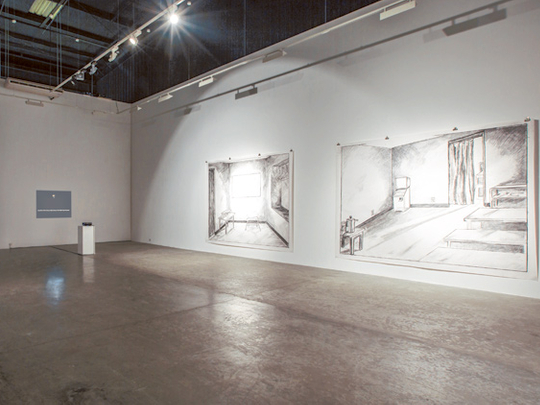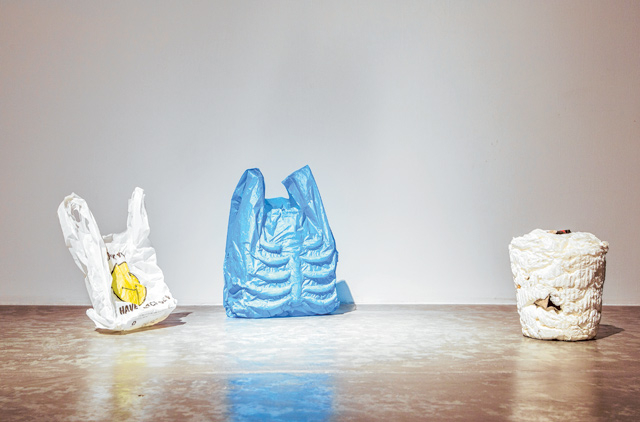
New York-based Palestinian artist Shadi Habib Allah’s latest exhibition, titled “Evacuated Containers”, is inspired by a personal experience. But by presenting a deconstruction of the entire experience, the artist invites viewers to construct new narratives based on their own perceptions of the scene and nature of the event.
Habib Allah is from occupied Jerusalem, and the incident which triggered his latest work occurred in 2009, when he was returning to New York after a visit to his hometown. “During my vacation I had been working on a sculpture of a leg. When the security officer at Ben Guiron airport in Tel Aviv spotted this piece in my baggage, she questioned me about it. Not satisfied with my answers, she took me to her superiors for further interrogation. I knew that the entire process was a game of intimidation and power play. So I also started playing with them, giving them my philosophical and humorous take on the functions of a leg and the meaning of that sculpture. But unknown to me, in another room, the officers destroyed the artwork. They showed me the pieces, warning me not to travel with such things, and all I returned home with was the piece of cloth in which the sculpture had been wrapped,” the artist recalls.
It was an emotional experience for Habib Allah to have his artwork stripped of its identity, and destroyed without his knowledge, based on the decision of an authority whom he could not question. “I could have recreated the sculpture, and to me the object itself did not mean anything. I needed to resolve my feelings by understanding the space where my artwork was destroyed and where it might still exist, albeit in pieces. That unknown space lay behind a curtain in the room where I was interrogated,” he says.
So three years later, when he met a Palestinian guard, who worked at the airport, Habib Allah requested him to try and gain access to that room. The man was able to do that and described the room and its surroundings to the artist. Habib Allah then approached a sketch artist at the New York Police Department to create sketches of that room and the areas around it, based on the verbal description provided by the guard. The drawings he is exhibiting are enlarged versions of those pencil sketches. When visitors enter the gallery, they get the feeling of being immersed in those empty spaces. Accompanying the sketches is a video that recreates the artist’s interrogation that day, playing out the entire cat-and-mouse game that took place between the Israeli security officers and him.
Although viewers may not know the exact circumstances represented by the video, they cannot miss the undertones of the intimidating strategies of the interrogators and the cynicism of the responder. Similarly, most people would recognise the interrogation rooms at the airport, complete with details such as the tools used to detect explosives; hammers used to destroy banned goods; and clothes hangers suggesting strip searches.
“These empty rooms are like containers from which the power has been evacuated. The illicit entry of the guard, the use of another power system in the form of an American policeman, and the transmission of the experience from one person to another dilutes the narrative until the authority is completely emptied out of the work, leaving just the bare elements of the room. The fact that these drawings are of spaces that I did not see, and they are based on the subjective perceptions of the guard and the sketch artist, separates them from my own memory of the experience. Since our perception of a space or a situation depends on our emotional state, I have tried to create a distance from the episode, so that I can look at it more objectively and rewrite the narrative. In the larger context, this work is about shedding emotional baggage, old memories and preconceived notions so that you can look afresh at a familiar situation, change your perceptions about it and find new strategies to deal with it. The empty room is like an empty stage, with some props, and has the potential to allow a new scene to unfold, where positions are reconfigured and a new narrative can emerge,” Habib Allah says.
The show also includes sculptures of a ribcage-shaped plastic shopping bag and another with a smiley face printed on it. The shapes suggest certain contents inside, but the bags are actually empty, playing with the idea of empty containers and perception. The bags also allude to the checking of baggage at airports, and the smiley face is the artist’s cynical reference to the polite façade put up by security officials even during the most unfriendly interrogations.
Habib Allah’s work may have a political message about thinking afresh to resolve the Palestinian-Israeli conflict. But it goes beyond that. “I want to ask questions about the way we all think. Our world is based on our perceptions and those can be changed only if we are able to distance ourselves from experiences and evacuate bad memories and histories from our mind. We need to start with an empty container to write a new story,” he says.
Jyoti Kalsi is an arts enthusiast based in Dubai.
“Evacuated Containers” will run at Green Art Gallery, Al Quoz, until May 5.



